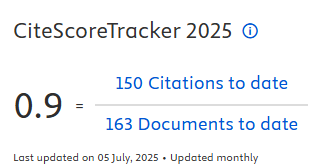The Correlation between Age, Years of Service, and Working Postures and the Complaints of Musculoskeletal Disorders
Downloads
ABSTRACT
Introduction: Musculoskeletal Disorders (MSDs) is one of the health problems caused by the used equipment or performed activity while working. The workers in the packaging section of the iron and steel industry who do the packaging process manually are exposed to the risk of experiencing MSDs due to the working attitudes and non-ergonomic postures. This study aims to identify the correlation between ages, years of service, as well as working postures and the complaints of MSDs experienced by the workers of the packaging section of iron and steel industry in Sidoarjo. Methods: This study applied a cross-sectional design. The research population was all workers in the packaging section of an iron and steel industry in Sidoarjo, reaching 27 people. The research samples are the total population of the workers in the packaging section of an iron and steel industry in Sidoarjo. The risk assessment of MSDs was carried out by using the Rapid Entire Body Assessment (REBA) method, while the risk complaints were measured by using the Nordic Body Map (NBM) questionnaire. The data were tested by using Chi-Square. Results: The results revealed that there were moderate correlations between the age and the MSDs complaints (phi coefficient=0.335), between the years of service and the MSDs complaints (phi coefficient=0.433), and between the working postures and MSDs complaints (phi coefficient=0.401). Conclusion: The moderate-level of correlation still affected the occurrence of MSDs complaints.
Keywords: ages, years of service, working postures, musculoskeletal disorders complaints
Ahmad, A. and Budiman, F. (2014) ‘The Correlation of Sitting Position with Lower Back Pain in Vermak Levis Tailors in Tanah Pasir Market, Penjaringan, North Jakarta, 2014', Forum Ilmiah, 11(3), pp. 412–420.
Albers, J. T. et al. (1997) ‘An Ergonomic Education and Evaluation Program for Apprentice Carpenters', American Journal of Industrial Medicine, 32(6), pp. 641–646.
Basahel, A. M. (2015) ‘Investigation of Work-related Musculoskeletal Disorders (MSDs) in Warehouse Workers in Saudi Arabia', in Procedia Manufacturing. Elsevier B.V., pp. 4643–4649.
Boshuizen, H. C., Bongers, P. M. and Hulshof, C. T. J. (1990) ‘Self-reported Back Pain in Tractor Drivers Exposed to Whole-Body Vibration', International Archives of Occupational Evironmental Health, 62(2), pp. 109–115.
Chaffin, D. B., Andersson, G. B. J. and Martin, B. J. (2006) Occupational Biomechanics. 4th edn. New York: John Willey & Son, Inc.
Choobineh, A. et al. (2007) ‘Musculoskeletal Problems Among Workers of an Iranian Rubber Factory', Journal of Occupational and Health, 49(5), pp. 418–423.
Chung, Y.-C. et al. (2013) ‘Risk of Musculoskeletal Disorder among Taiwanese Nurses Cohort: A Nationwide Population-based study', BMC Musculoskeletal Disorders, 14(144), pp. 1–6.
Cooper, K. H. (1994) Antioxidant Revolution. Nashville: Thomas Nelson Publisher.
Ide, P. (2007) Inner Healing in The Office. Jakarta: Gramedia.
Jalajuwita, R. N. and Paskarini, I. (2015) ‘The Relation between Body Position with Musculoskeletal Complaints in Welding Unit of PT. X Bekasi', The Indonesian Journal of Occupational Safety and Health, 4(1), pp. 33–42.
Notoatmodjo, S. (2005) Health Research Methodology. Jakarta: Rineka Cipta.
Nurhikmah (2011) Factors Associated With Musculoskeletal Disorders (MSDs) in Furniture Workers in the Benda Kota District of Tangerang in 2011. Undergraduate Thesis. Jakarta:Faculty of Medicine and Health Sciences Universitas Islam Negeri Syarif Hidayatullah.
Rosecrance, J. et al. (2011) ‘Musculoskeletal Disorders among Construction Apprentices in Hungary', Central European Journal of Public Health, 9(4), pp. 183–187.
Santoso, G. (2004) Ergonomics: Humans, Equipment, and the Environment. Jakarta: Prestasi Pustaka.
Saputra, A. M. T. H., Naiem, F. M. and Saleh, L. M. (2013) ‘Factors Related with Musculosceletal Disorders on Hasanuddin University Makassar Financial Department's Computer Operator', Repository Universitas Hasanuddin, pp. 1–12.
Suma'mur (2009) Corporate Hygiene & Occupational Health. Jakarta: Sagung Seto.
Tana, L., Delima and Tuminah, S. (2009) ‘The Relation between Work Duration and Work Position to Neck and Upper Extremity Musculoskeletal Symptoms among Female Garment Workers in North Jakarta', Bulletin of Health Research, 37(1), pp. 12–22.
Tarwaka (2010) Industrial Ergonomics: Basics of Ergonomics Knowledge and Applications at Work. Solo: Harapan Press Solo.
Tarwaka, Bakri, S. H. A. and Sudiajeng, L. (2004) Ergonomics for Safety, Occupational Health and Productivity. 1st edn. Surakarta: UNIBA Press.
Woolf, A. D. and Pfleger, B. (2003) ‘Burden of Major Musculoskeletal Conditions', Bulletin of the World Health Organization, 81(19), pp. 646–656.
Yousefi, H., Habibi, E. and Tanaka, H. (2016) ‘Prevalence of Work Related Musculoskeletal Disorders Among the Iranian Working Population in Different Sectors of Industries', in Goossens, R. H. M. (ed.) International Conference on Social and Occupational Ergonomics. Florida: Walt Disney World.

In order to be accepted and published by The Indonesian Journal of Occupational Safety and Health, Author(s) who submit an article should complete all the review process. The copyright of received articles assigned to the The Indonesian Journal of Occupational Safety and Health and Department of Safety and Health, Universitas Airlangga as publishers of the journal. The intended copyright includes the rights to publish articles in various forms (including reprints).
The Editorial Team of The Indonesian Journal Of Occupational Safety and Health and Department of Safety and Health strive to ensure that no errors occur in the articles that have been published, both data errors and statements in the article.
Users of this website will be licensed to use materials from this website following the Creative Commons Attribution-NonCommercial-ShareAlike 4.0 International License. No fees charged. Please use the materials accordingly.
------------------------------------------------------------------------------------------------------------------------------------------------------------------------------------------
Attribution ” You must give appropriate credit, provide a link to the license, and indicate if changes were made. You may do so in any reasonable manner, but not in any way that suggests the licensor endorses you or your use.
NonCommercial ” You may not use the material for commercial purposes.
ShareAlike ” If you remix, transform, or build upon the material, you must distribute your contributions under the same license as the original.







 How to Submit Articles in OJS
How to Submit Articles in OJS

























